![]()
![]()
The German settlements in the Black Sea Region1
The February Revolution
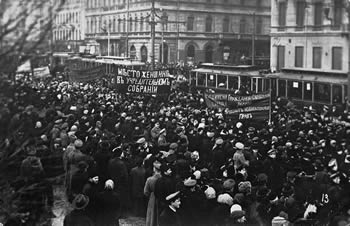
Demonstrations in Petrograd 1917
In the first few weeks of 1917, the "unity between the monarch people" finally disintegrated.
In mid-February 1917, the governmental capital Petrograd2, was paralyzed. Newspapers ceased publication, food supplies collapsed and starving people cried in the streets, "Give us bread, we starve, we need bread."3
A unified, organized central government no longer existed. At military headquarters, the Tsar was overwhelmed by issues of warfare. The Duma4 was dismissed and its sessions were adjourned to February 27th.
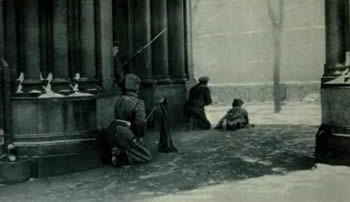
Unrest in Petrograd
The Petrograd garrison, consisting of 160,000 men, remained mostly passive. However, there were signs of of growing fraternization between the soldiers, the striking workers and the starving women.
On 25 February/10 March 1917, Tsar Nicholas II issued the command to the Petrograd garrison to fire upon the citizenry, which was obeyed. Corpses of Russian workers were on the streets and no one seemed to take offense to it. The overthrow of the government occurred on the night of 27 February/12 March.
Countless masses of soldiers and workers roamed excitedly through the streets. They cried, hugged and were joyfully enthusiastic about the victory over the system, the bourgeoisie, and the terrible injustices suffered by them for 100 years. The nation reeled in happiness and bliss; everywhere the fulfillment and completion of their dreams was celebrated.
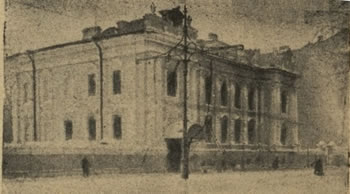
burned headquarter of the political police
The arsenal, opened by the troops, was released to the citizens. The crowds opened the prisons and freed the inmates. The headquarters of the political police was burned.
This initial joy and enthusiasm, coupled with the awareness of the newly received power and the impulse to show and use this power, soon degenerated into disarray and in chaos without equal. It resulted in acts of violence, arrests, interrogations, gunfights, executions, attacks on German colonies, minor and major street battles between workers and soldiers, and also between individuals and political departments.
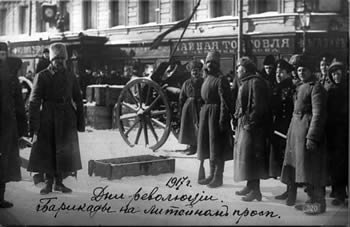
A Barricade during the February Revolution
Soon all over Russia, there was no public or private building that bear traces of these fights; no house without ball strikes or other traces of damage.
Men repeatedly shot, mostly at well-dressed people, such as officers, doctors, teachers and professors. A very large part of the Russian intelligentsia fell victim to this rash of uncontrolled, unbridled rage in the first days and weeks after the revolution.
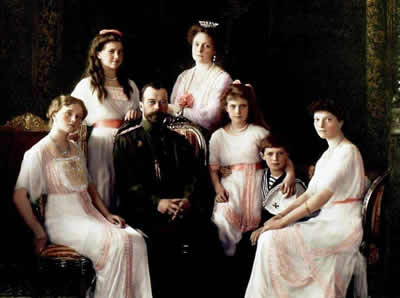
Nicholas II and his Family
The Tsar was and remained incapable of acting. Under the pressure of events, Tsar Nicholas II signed his abdication on 2 March/15. March 1917. The Russian monarchy was dissolved. Thus, the February Revolution achieved its goal. Together with his wife and family, Tsar Nicholas II was exiled to Yekaterinburg in the Ural Mountains. He and his family were murdered there by the Bolsheviks5 in the course of the revolution on the night of 16-17July 1918.
The majority of Russian Germans, who had suffered from the uncertainty of their existence in the last phase of the tsarist regime, welcomed the revolutionary overthrow and the Provisional Government which emerged from it with joy and confidence.
1 Thanks to Peggy R-H. for assistance in editing the English translation of this article.
2 After the outbreak of the First World War, again and again, there were riots against the German population, so that the Russian Government took a series of special precautions. The German-sounding name of the capital of Saint Petersburg was renamed into Petrograd (Peter's town) on August 18, 1914. After Lenin's death in 1924, the city was renamed Leningrad on January 26, 1924. After a referendum in 1991, the city reverted to its original name: Saint Petersburg.
3 Jones Stinten: „Russland in Revolution - By an eye-withness“, H. Jenkins Ltd, London SW 1917, page 79f;
4 Duma = A form of Russian governmental institution that was formed during the reign of the last Tsar, Nicholas II.
5 Bolsheviks = is the former name for party members of the CPSU (Communist Party of the Soviet Union). The term originated in 1903 at the second party Congress of the Russian Social Democratic Labor Party (RSDLP) in London. Lenin's followers presented at this Congress the majority (Russian: bolschinstwo) which is why they were called Bolsheviks. The minority (Russian: menschinstwo) were called Mensheviks.
The Bolsheviks were much more radical than the other parts of the party. They wanted the imminent fall of the Tsar and the associated introduction of communism. The Mensheviks pursued the same goal but wanted to initiate reforms.
At the outbreak of the First World War, the Bolsheviks condemned Russia's participation as Imperialist aggression. They increased greatly in growth as the troops of the Tsar had suffered setbacks on almost all fronts.
During the October revolution of 1917, they were the strongest power in the country. Vladimir Ilyich Lenin, who returned from exile took over the leadership of the Communists. His power was based partly on the repression of his opponents.
Leon Trotsky, the People's Commissar for Warfare, formed, after the peace treaty of Brest-Litovsk which he regarded as a personal defeat; the Red labor and peasant army with which he successfully proceeds to command in the Russian civil war (1917/18-1920) against the Tsarist, civil white army.
Until 1922, the Bolsheviks managed to control almost the whole East of the vast Russian Empire. With it was connected the so-called war of communism, an economic policy that placed all companies under State control. Further repressive measures led to extreme shortages and riots within the population.
After 1918 the Bolsheviks called themselves the Communist Party and from 1925 the Communist Party of the Soviet Union with the annex (Bolsheviks). Reprisals against the Soviet population increased in the country especially during Stalin's time. The secret police repressed any opposition and many critics and potential enemies were arrested and killed in purges. In this way, the Communist Party ruled the country for a long time.




